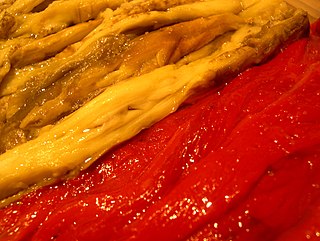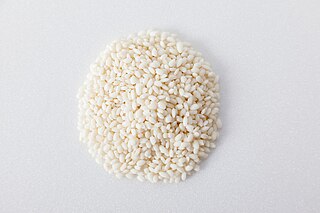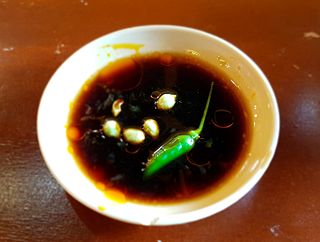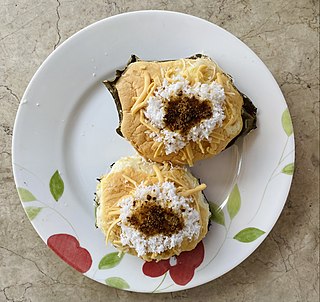| Alternative names | Minanok |
|---|---|
| Course | Main course, side dish |
| Place of origin | Philippines |
| Serving temperature | Warm |
| Main ingredients | Coconut milk, banana blossom/eggplant, red onion, salt, black pepper, vinegar |
| Variations | kulawong talong, kulawong puso ng saging |
Kulawo is a Filipino salad made with either minced banana blossoms (kulawong puso ng saging) or grilled eggplants (kulawong talong) cooked in coconut milk that is distinctively extracted from grated coconut meat toasted on live coals. It is a pre-colonial dish that originates from the provinces of Laguna and Quezon. Kulawo is a type of kilawin and ginataan. [1] [2] It is fully vegan and has a unique smoky taste that has been compared to smoked meat or fish dishes. [3] [2] [4]
Kulawo uses either banana blossoms or eggplants. For banana blossoms, it is finely diced or julienned and is mixed with salt for a few minutes and then squeezed dry and washed to remove the bitter sap. For eggplants, it is first grilled until soft and then peeled and mashed. Grated coconut is then placed in a container with live coals (usually from burning coconut husks) until the grated coconut is toasted brown and emits a slightly burned odor. In modern versions, they can also be toasted briefly in an oven. The toasted grated coconut is then separated from the coals and moistened with vinegar. It is allowed to cool down and then squeezed to extract coconut milk that now has a smoky flavor. The coconut milk is then heated slowly with vinegar (usually coconut or cane vinegar), red onions, salt, and black pepper. Other spices can also be added to taste, including garlic, ginger, shallots, fish sauce, and chili peppers. The coconut milk must be heated slowly and prevented from boiling to avoid curdling. The banana blossoms are then added last and cooked until tender. [1] [5] [2] [6]
Kulawong puso ng saging is also sometimes known as minanok (literally "done like chicken"), due to its texture being similar to shredded chicken. Despite the name, it does not contain any meat. [4]
Some versions do add cooked meat, like pork belly (liempo), especially in adaptations in other regions. But this is non-traditional. [7]

Escalivada, also sometimes transcribed in French as 'escalibade' and in Spanish as escalibada, is a traditional dish from Roussillon, Catalonia, Valencia, Murcia and Aragón of smoky grilled vegetables. It typically consists of roasted eggplant and bell peppers with olive oil and sometimes onion, tomato, minced garlic, and salt.

Glutinous rice is a type of rice grown mainly in Southeast and East Asia, and the northeastern regions of South Asia, which has opaque grains, very low amylose content, and is especially sticky when cooked. It is widely consumed across Asia.

Scrambled eggs is a dish made from eggs stirred, whipped, or beaten together typically with salt, butter, oil, and sometimes other ingredients, and heated so that they form into curds.

Otak-otak is a Southeast Asian fish cake made of ground fish mixed with spices and wrapped in leaf parcels. Otak-otak is traditionally served steamed or grilled, encased within the leaf parcel it is cooked in, and can be eaten solely as a snack or with steamed rice as part of a meal.

Filipino cuisine is composed of the cuisines of more than a hundred distinct ethnolinguistic groups found throughout the Philippine archipelago. A majority of mainstream Filipino dishes that compose Filipino cuisine are from the food traditions of various ethnolinguistic groups and tribes of the archipelago, including the Ilocano, Pangasinan, Kapampangan, Tagalog, Bicolano, Visayan, Chavacano, and Maranao ethnolinguistic groups. The dishes associated with these groups evolved over the centuries from a largely indigenous base shared with maritime Southeast Asia with varied influences from Chinese, Spanish, and American cuisines, in line with the major waves of influence that had enriched the cultures of the archipelago, and adapted using indigenous ingredients to meet local preferences.

The generic term for condiments in the Filipino cuisine is sawsawan. Unlike sauces in other Southeast Asian regions, most sawsawan are not prepared beforehand, but are assembled on the table according to the preferences of the diner.

Bibingka commonly refers to a type of baked rice cake from the Philippines that is traditionally cooked in a terracotta oven lined with banana leaves and is usually eaten for breakfast or as merienda especially during the Christmas season. It is also known as bingka in the Visayas and Mindanao islands.

A rice cake may be any kind of food item made from rice that has been shaped, condensed, or otherwise combined into a single object. A wide variety of rice cakes exist in many different cultures in which rice is eaten. Common variations include cakes made with rice flour, those made from ground rice, and those made from whole grains of rice compressed together or combined with some other binding substance.

Pasteles, also pastelles in the English-speaking Caribbean, are a traditional dish in several Latin American and Caribbean countries. In Puerto Rico, the Dominican Republic, Venezuela, Panama, Trinidad and Tobago, and the Caribbean coast of Colombia, the dish looks like a tamal. In Hawaii, they are called pateles in a phonetic rendering of the Puerto Rican pronunciation of pasteles, as discussed below.

Suman or budbud is a rice cake originating in the Philippines. It is made from glutinous rice cooked in coconut milk, often wrapped in banana leaves, coconut leaves, or buli or buri palm (Corypha) leaves for steaming. It is usually eaten sprinkled with sugar or laden with latik. A widespread variant of suman uses cassava instead of glutinous rice.

Kinilaw is a raw seafood dish and preparation method native to the Philippines. It is sometimes also referred to as Philippine ceviche due to its similarity to the Latin American dish ceviche. It is more accurately a cooking process that relies on vinegar and acidic fruit juices to denature the ingredients, rather than a dish, as it can also be used to prepare meat and vegetables. Kinilaw dishes are usually eaten as appetizers before a meal, or as finger food with alcoholic drinks. Kinilaw is also sometimes called kilawin, especially in the northern Philippines, but the term kilawin more commonly applies to a similar lightly grilled meat dish.

Philippine adobo is a popular Filipino dish and cooking process in Philippine cuisine. In its base form, meat, seafood, or vegetables are first browned in oil, and then marinated and simmered in vinegar, salt and/or soy sauce, and garlic. It has occasionally been considered the unofficial national dish in the Philippines.

Botok or ꦧꦺꦴꦛꦺꦴꦏ꧀(Bothok) is a traditional Javanese dish made from grated coconut flesh which has been squeezed of its coconut milk, often mixed with other ingredients such as vegetables or fish, and wrapped in banana leaf and steamed. It is commonly found in the Javanese people area of Java Island (Yogyakarta Special Region, Central, and East Java. It has a soft texture like the mozzarella cheese and is usually colored white.

Inihaw, also known as sinugba or inasal, are various types of grilled or pit-roasted barbecue dishes from the Philippines. They are usually made from pork or chicken and are served on bamboo skewers or in small cubes with a soy sauce and vinegar-based dip. The term can also refer to any meat or seafood dish cooked and served in a similar way. Inihaw are commonly sold as street food and are eaten with white rice or rice cooked in coconut leaves (pusô). Inihaw is also commonly referred to as Filipino barbecue or (informally) Pinoy BBQ.

Paksiw is a Filipino style of cooking, whose name means "to cook and simmer in vinegar". Common dishes bearing the term, however, can vary substantially depending on what is being cooked.

Tortang talong, also known as eggplant omelette, is an omelette or fritter from Filipino cuisine made by pan-frying grilled whole eggplants dipped in an egg mixture. It is a popular breakfast and lunch meal in the Philippines. A common variant of tortang talong is rellenong talong, which is stuffed with meat, seafood, and/or vegetables.

Ginataang kalabasa, also known as kalabasa sa gata, is a Filipino vegetable stew made from calabaza in coconut milk and spices. It commonly includes shrimp and yardlong beans and either bagoong or patis. It can also be cooked with fish, crab, or meat and a variety of other ingredients. It is a creamy umami-laden dish that is naturally slightly sweet due to the calabaza. It is a type of ginataan.

Poqui poqui, also spelled puke puke or puki puki, is a Filipino eggplant and scrambled eggs dish originating from the Ilocos Region of Northern Luzon in the Philippines. It is very similar to tortang talong in that the eggplant is first grilled directly on an open flame, then peeled and mashed. It is then added to ginisa and scrambled eggs. It is garnished with spring onions. It has a creamy texture and is usually eaten as a side dish to grilled fish and meat dishes, but it can also be eaten with white rice. It is believed that the name of poqui poqui may have originated from the Hawaiian dish poke due to the influx of Ilocano sugarcane workers to Hawaii during the American colonization of the Philippines, although they are very different dishes.